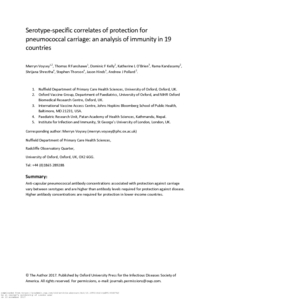Voysey, M; Fanshawe, TR; Kelly, DF; O'Brien, KL; Kandasamy, R; Shrestha, S; Thorson, S; Hinds, J; Pollard, AJ
(2018)
Serotype-specific correlates of protection for pneumococcal carriage: an analysis of immunity in 19 countries.
Clin Infect Dis, 66 (6).
pp. 913-920.
ISSN 1537-6591
https://doi.org/10.1093/cid/cix895
SGUL Authors: Hinds, Jason
![[img]](https://openaccess.sgul.ac.uk/109304/1.hassmallThumbnailVersion/cix895.pdf)  Preview |
|
PDF
Accepted Version
Available under License ["licenses_description_publisher" not defined].
Download (464kB)
| Preview
|
Abstract
Background: Pneumococcal conjugate vaccines (PCVs) provide direct protection against disease in those vaccinated, and interrupt transmission through the prevention of nasopharyngeal carriage. Methods: We analysed immunogenicity data from 5224 infants who received PCV in prime-boost schedules. We defined any increase in antibody between the one-month post-priming visit and the booster dose as an indication of nasopharyngeal carriage ('seroincidence'). We calculated antibody concentrations using receiver-operator characteristic curves, and used generalised additive models to compute their protective efficacy against seroincidence. To support seroincidence as a marker of carriage, we compared seroincidence in a randomised immunogenicity trial in Nepal with the serotype-specific prevalence of carriage in the same community. Findings: In Nepalese infants, seroincidence of carriage closely correlated with serotype-specific carriage prevalence in the community. In the larger data set, antibody concentrations associated with seroincidence were lowest for serotypes 6B and 23F (0.50 µg/mL and 0.63 µg/mL respectively), and highest for serotypes 19F and 14 (2.54 µg/mL and 2.48 µg/mL respectively). The protective efficacy of antibody at these levels was 62% and 74% for serotypes 6B and 23F, and 87% and 84% for serotypes 19F and 14. Protective correlates were on average 2.15 times higher in low/lower middle income countries than in high/upper middle income countries (GMR 2.15, 95%CI 1.46-3.17, p=0.0024). Interpretation: Antibody concentrations associated with protection vary between serotypes. Higher antibody concentrations are required for protection in low-income countries. These findings are important for global vaccination policy, to interrupt transmission by protecting against carriage.
| Item Type: |
Article
|
| Additional Information: |
This is a pre-copyedited, author-produced version of an article accepted for publication in Clinical Infectious Diseases following peer review. The version of record Merryn Voysey, Thomas R Fanshawe, Dominic F Kelly, Katherine L O’Brien, Rama Kandasamy, Shrijana Shrestha, Stephen Thorson, Jason Hinds, Andrew J Pollard; Serotype-Specific Correlates of Protection for Pneumococcal Carriage: An Analysis of Immunity in 19 Countries, Clinical Infectious Diseases, Volume 66, Issue 6, 5 March 2018, Pages 913–920 is available online at: https://doi.org/10.1093/cid/cix895 |
| Keywords: |
Microbiology, 06 Biological Sciences, 11 Medical And Health Sciences |
| SGUL Research Institute / Research Centre: |
Academic Structure > Infection and Immunity Research Institute (INII) |
| Journal or Publication Title: |
Clin Infect Dis |
| ISSN: |
1537-6591 |
| Language: |
eng |
| Dates: |
| Date | Event |
|---|
| 15 March 2018 | Published | | 21 October 2017 | Published Online | | 19 October 2017 | Accepted |
|
| Publisher License: |
Publisher's own licence |
| Projects: |
|
| PubMed ID: |
29069415 |
 |
Go to PubMed abstract |
| URI: |
https://openaccess.sgul.ac.uk/id/eprint/109304 |
| Publisher's version: |
https://doi.org/10.1093/cid/cix895 |
Statistics
Item downloaded times since 05 Dec 2017.
Actions (login required)
 |
Edit Item |



